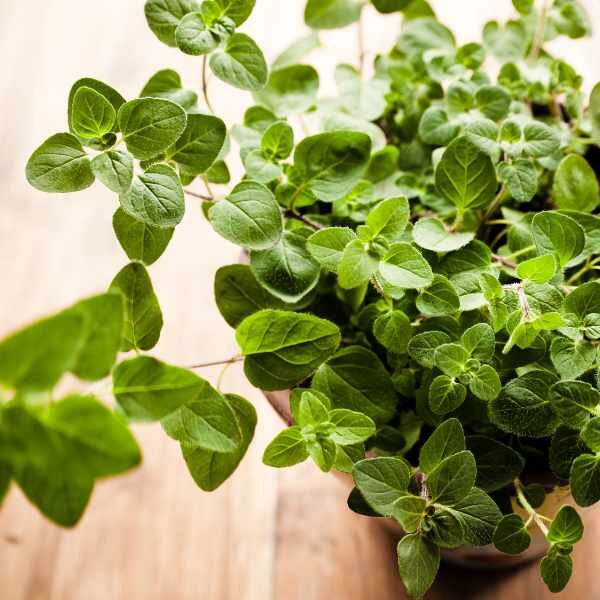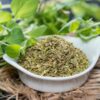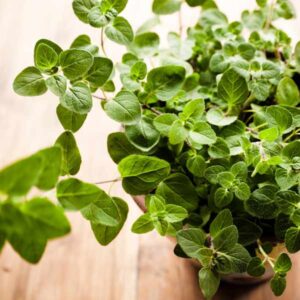Oregano Vulgare
$4.95
Origanum Vulgare
- Seed Count 2000
- Makes An Aromatic Ground Cover
- Perennial
In stock
Description
Oregano Vulgare is one of those unassuming plants that quietly earns its place in gardens and kitchens alike. A perennial herb native to the Mediterranean, it’s a rugged, resilient species that thrives in Australia’s diverse climates, from the dry heat of the outback to the cooler, coastal regions.
What makes Oregano Vulgare particularly appealing is its adaptability. Once established, it shrugs off drought, poor soil, and neglect and it’s unfazed by sandy soils common in coastal areas and thrives in the well-drained conditions of raised beds or containers. While it appreciates a sunny spot, it won’t sulk in partial shade, though its essential oils, and thus its flavour, are most concentrated when grown in full sun.
Botanically speaking, oregano is a member of the mint family, though it lacks the aggressive spreading habit of its relatives. Instead, it forms tidy clumps of small, oval leaves with a slightly fuzzy texture, ranging in colour from deep green to silvery-grey and in summer, it sends up delicate spikes of tiny pink or white flowers that hum with bees and other pollinators.
In the kitchen, Oregano Vulgare is a cornerstone of Mediterranean cuisine, but its appeal stretches far beyond pizza and pasta with its fresh leaves adding a zesty, slightly bitter kick to grilled meats, roasted vegetables, and hearty stews. Dried, the flavour intensifies, becoming richer and more complex, making it a pantry essential for preserving and it’s particularly well-suited to lamb where its pungency cuts through the meat’s richness.
Beyond the plate, Oregano has a rich history as a herbal remedy. Ancient Greeks and Romans revered it for its purported healing properties, and modern herbalists still value it for its high concentrations of antioxidants, antimicrobial compounds, and essential oils like thymol and carvacrol.
| Method: Sow direct or seedlings | Soil Temp: 18°C - 25°C |
| Cool Mountain: Oct - Mar | Position: Full sun |
| Arid: Sep - Mar | Row Spacing: 15cm apart |
| Temperate: Sep - May | Planting Depth: 5mm |
| Sub Tropical: Aug - May | Harvest: 95 days |
| Tropical: May - Aug | Plant Height: 15cm |
Basics
- Capsicum (sweet/bell Capsicum) thrives in warm, sunny gardens.
- Plant them in a spot with full sun (6+ hours) and rich, well-drained soil.
- Prepare the bed by removing weeds and digging in plenty of compost or aged manure.
- Use mulch around plants to retain moisture and suppress weeds.
Seed Trays vs Direct Sowing
Seedling Trays:
- Raise seeds in pots or trays filled with seedling mix, keeping them warm (16-35°C) and moist.
- This protected start speeds germination and gives plants a head start on weeds and weather.
- You’ll use fewer seeds and get sturdy seedlings for an earlier crop.
- The downside is extra effort and cost (pots, mix, heat source) and you must harden-off seedlings before planting out.
Direct Sowing:
- Plant seeds 3mm deep in the garden soil 50cm between plants, 60–100cm once it’s warm and frost-free.
- Direct sowing is simpler and cheaper (no trays or special mix), but germination is slower and more vulnerable to cold, pests or heavy rain.
- Capsicum seeds can take 1–3 weeks to sprout at 16–35°C.
- Ensure the soil stays evenly moist (not waterlogged) during this time.
In short: use trays if you want the best germination and an early start; sow direct if you prefer simplicity and have already warm conditions.
Planting and General Care
Timing & Spacing:
- Plant or transplant capsicum after all danger of frost has passed.
- In tropical/subtropical areas, Capsicums can even fruit year-round, but in cooler zones treat them as an annual summer crop.
Soil:
- Use well-drained, fertile soil rich in organic matter.
- Work in compost or aged manure before planting.
- Capsicums prefer a slightly acidic to neutral pH (~6.0–7.0).
- In pots, use at least ~40L per plant.
Watering:
- Water deeply and regularly, so the soil stays evenly moist.
- Check soil moisture by pushing a finger 4–5cm down; water when that layer is just dry.
- Water in the early morning or late afternoon to minimize stress.
- Avoid wetting the leaves, which can encourage fungal disease.
- Mulch around plants to keep roots cool and reduce evaporation.
Fertilising:
- If the soil was well-prepared, you may need little extra feed.
- Otherwise, apply a balanced (e.g. 10-10-10 NPK) slow-release fertilizer at planting.
- Once flowers and fruit start, give a liquid tomato or vegetable fertilizer every few weeks according to label directions.
- This supports heavy fruiting. Avoid excessive nitrogen late in the season, as it can reduce fruit set.
Staking & Pruning:
- Capsicum plants can get top-heavy with fruit. Stake or cage them when planting.
- A simple sturdy stake beside each plant works – gently tie the main stem (e.g. with soft string) as it grows.
- This prevents wind damage and keeps fruit off the ground.
- Remove any low or damaged leaves to improve air flow.
- Many gardeners also pinch out a few early flower buds when plants are young – this encourages stronger vegetative growth and heavier later yields.
- Overall, little pruning is needed beyond this.
Pest & Disease Management:
- Monitor plants for pests like aphids, caterpillars, slugs/snails, and chilli thrip.
- Hand-pick pests or use organic sprays if needed.
- Practice good hygiene: remove weeds and crop debris.
- Rotate capsicum/solanaceous crops to a different spot each year to reduce disease pressure.
- Common diseases include blossom-end rot (from inconsistent watering or low calcium) and fungal spots.
- Regular watering and mulch help prevent blossom-end rot.
- Crop rotation and not overcrowding plants also reduce problems.
Chilli Thrips: What They Are & How to Deal With Them
- Chilli thrips (Scirtothrips dorsalis) are tiny, slender insects that can cause big problems in home veggie patches—especially for capsicum, chilli, eggplant, and tomato plants.
- You might not see them easily (they’re less than 2mm long!), but the damage is easy to spot as leaves curl or look bronzed and scarred, buds drop off, and fruit can become deformed or scarred.
- These pests feed by piercing plant tissue and sucking out the juices, which leads to silvery or brown patches on leaves and distorted growth.
- They tend to hang out on the newest growth, flower buds, or the undersides of leaves—so grab a magnifying glass and check these spots first if your plants are looking stressed.
What You Can Do:
Prevention is key:
- Start clean – Avoid bringing in infested seedlings or cuttings.
- Attract beneficial bugs like lady beetles, lacewings, and predatory mites—they’ll help keep thrip numbers down.
- Plant flowers like alyssum, marigold, or dill nearby to draw in the good guys.
If they show up:
- Prune affected areas early to stop the spread.
- Hose them off gently with water to dislodge thrips from foliage.
- Apply insecticidal soap or horticultural oil, covering all leaf surfaces, especially underneath. Repeat weekly as needed.
- Rotate your crops each year to disrupt their lifecycle.
Tip: Thrips love hot, dry conditions—so keep your plants well-watered and mulched to reduce stress and deter infestations.
Companion Planting with Capsicum
Good companions:
- Herbs & Flowers: Basil, dill, parsley, coriander, chamomile and other aromatic herbs as they attract beneficial insects and may repel aphids or whiteflies. Garlic, onions, chives as their strong scent deters many pests. Marigolds, nasturtiums, borage, lavender as these flowers lure pollinators and trap pests (marigolds are famous for nematode control).
- Vegetables: Carrots, lettuce, spinach as they occupy shallow roots and don’t compete much with Capsicums. These can provide light ground cover under Capsicum plants. Tomatoes are sometimes planted alongside Capsicums (both like similar conditions) but be aware they share some pests/diseases so give them space and rotate beds regularly.
- Fruits: Strawberries and cucumbers have been noted as decent neighbours (shallow roots and shade from cucumber leaves can protect Capsicums).
Bad Companions
- Other heavy feeders or close relatives.
- Do not grow next to eggplants, potatoes or tomatoes in succession, as they share pests/diseases.
- Stay away from beans/peas and plants like fennel or dill, which can inhibit Capsicum growth.
- Squash and pumpkins (deep-rooted cucurbits) can out-compete Capsicums for nutrients.
- In short, pair Capsicums with light-feeders and pest-deterring plants, and keep them apart from other nightshades and big gourds.
Seed Saving
Saving your own Capsicum seeds is easy if you follow a few simple steps:
Select plants:
- Pick the healthiest plants with strong, typical fruit.
- If growing multiple types, isolate them (e.g. bag flowers or keep 20m+ apart) to prevent cross-pollination.
Harvest ripe fruits:
- Wait until Capsicums are fully ripe on the plant which is usually when they’ve changed to their final colour and just start to soften or wrinkle.
- Allowing fruits to over ripen a little ensures the seeds are mature.
Extract seeds:
- Cut the Capsicum in half and scoop or twist out the central core.
- Scrape out the seeds and remove as much of the inner flesh and pith as possible.
- Rinse the seeds in clean water to wash off any remaining pulp which helps them dry cleanly.
Dry seeds:
- Spread the seeds in a single layer on paper towels or a clean plate in a dry, shaded place.
- Let them dry completely over several days.
- They’re ready when you can crunch a seed in your fingers and it snaps rather than bends.
- Moisture is the enemy of seed storage, so make sure they feel fully dry.
Store seeds:
- Transfer the dried seeds to a paper envelope or small jar with a tight lid.
- Label with variety and date.
- Store in a cool, dark, dry spot (a refrigerator works well).
- Properly stored Capsicum seeds remain viable for about 3–4 years, so you’ll have plants for many seasons.
Climate & Timing
Oregano thrives in warm, sunny climates but adapts to most Australian regions.
- Cool regions: Sow in spring after frost risk (Sept–Nov).
- Warm/tropical regions: Avoid extreme heat; plant in early spring or autumn.
Soil Preparation
Soil type:
- Well draining, slightly alkaline to neutral soil (pH 6.5–7.0).
- Enrich with compost or aged manure for drainage.
Containers:
- Use pots greater than 30cm wide with quality potting mix.
Sowing Seeds
Depth:
- 2mm surface sow, light aids germination.
Spacing:
- Thin seedlings to 30 – 50cm apart.
Germination:
- 7 – 14 days at 18–25°C.
- Keep soil moist but not soggy.
Care & Maintenance
Sunlight:
- 6–8 hours daily.
- Partial shade in hot climates.
Watering:
- Let soil dry between waterings; avoid waterlogging.
Fertiliser:
- Minimal needs.
- Apply balanced liquid feed monthly if growth stalls.
Pruning:
Pinch tips to encourage bushiness.
Cut back after flowering.
Harvesting
- Begin harvesting leaves 6–8 weeks after planting.
- Snip stems before flowering for peak flavour.
- Dry leaves by hanging stems upside down in a warm, dark place.
Companion Planting Guide
Oregano’s strong scent repels pests and attracts pollinators.
Best Companions:
- Tomatoes, Capsicum & Chilli: Repels aphids, spider mites, and cabbage moths.
- Brassicas (Cabbage, Cauliflower): Deters cabbage worms and beetles.
- Grapes: Protects against pests like grapevine moth.
- Lavender & Thyme: Shared sun/soil preferences; enhances pest resistance.
Avoid Planting With:
- Cucumbers & Zucchini: Competes for nutrients and moisture.
- Potatoes: Prefers acidic soil (oregano thrives in neutral/alkaline).
- Mint: Invasive roots overwhelm oregano.
Seed Saving Guide
Selecting Plants
- Choose healthy plants for seeds.
Harvesting Seeds
- Allow flowers to mature and turn brown usually late summer.
- Cut seed heads and dry in a paper bag.
- Shake dried heads to release tiny seeds.
- Sieve to remove chaff.
Storage
- Store seeds in airtight containers (e.g., glass jars) in a cool, dark place.
- Label with date and variety.
Viability:
- 2–3 years if stored properly.
Troubleshooting Common Issues
Pests:
- Aphids and spider mites – spray with soapy water or neem oil.
Diseases:
- Root rot from overwatering – ensure good drainage.
Leggy Growth:
- Insufficient sunlight – relocate to a sunnier spot.
Regional Tips for Australia
Tropical Zones:
- Mulch to retain moisture and improve airflow.
Cool Zones:
- Mulch heavily in winter to protect roots.
Postage Charge
Orders under $30 attract a $4.95 shipping charge. Orders $30 and above have free shipping.
Order Times
Seed orders are normally dispatched within three business days. You will receive an email when seeds are mailed out.
Postage Days
Seeds are mailed out Monday to Friday at 1pm. Except for the Friday of long weekends.
Postage Times
WA 2-3 Days: SA,NT 3-5 Days: NSW, ACT, QLD, VIC: 5-7 Days
Carrier
We use Australia Post Letter Postage for the majority of orders
Not only are our seeds packed in recycled paper envelopes, we keep the theme going when we post out website orders. To protect your seeds from moisture and the letter box munchers (snails), we use a very special plastic free material made from plants. They are then put into recycled mailing envelopes. Green all the way 💚🌿












2 reviews for Oregano Vulgare